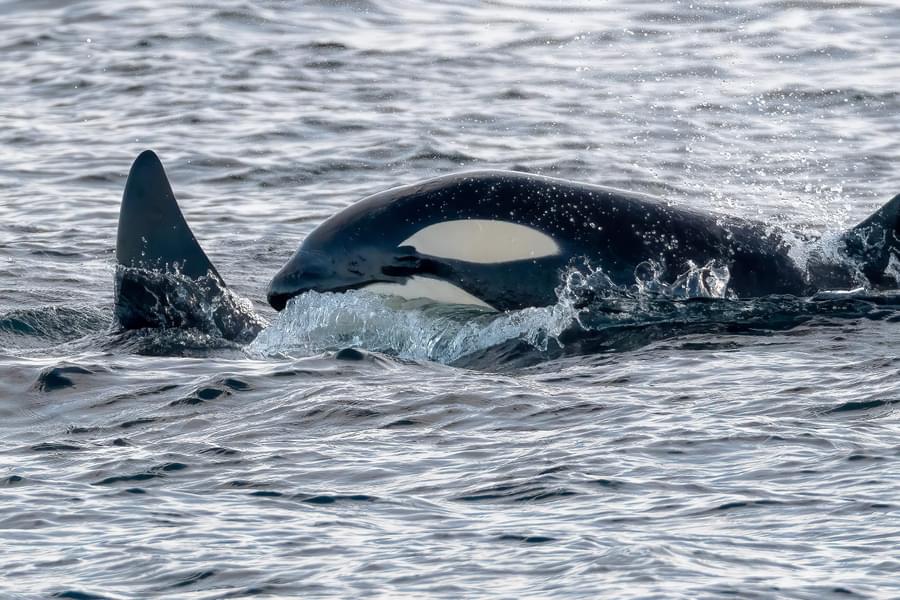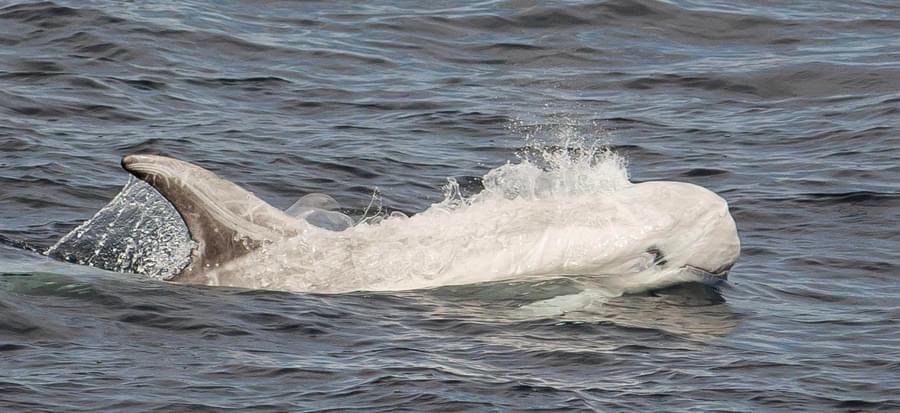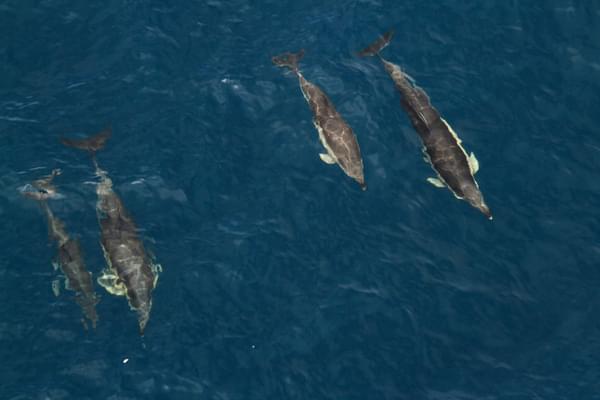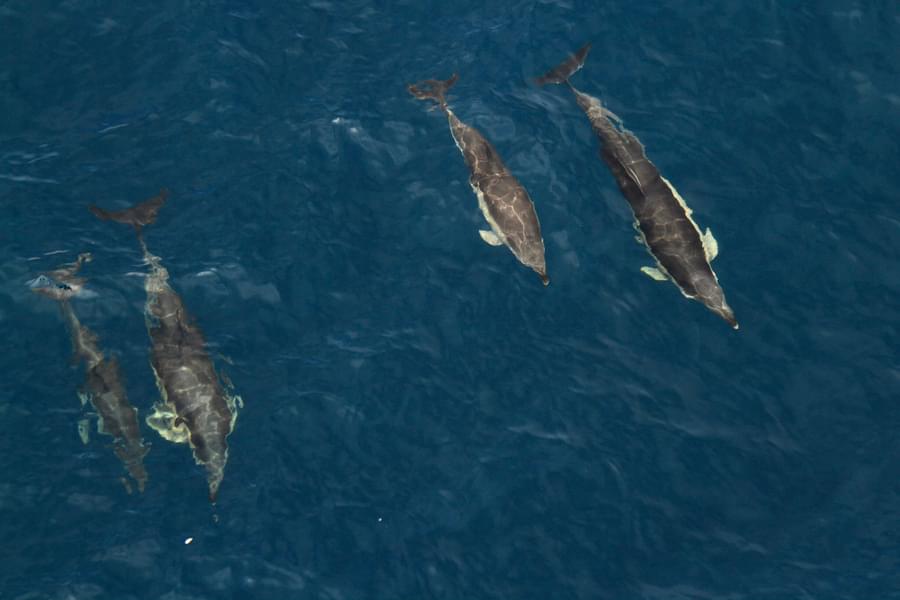National Dolphin Day is a day to celebrate and raise awareness of these fascinating, complex and intelligent marine mammals and highlight the threats they are facing across the world.
Dolphins exhibit remarkable diversity in their physical appearance, behaviours, social structures and a wide range of other characteristics. There are so many amazing species of dolphin that we can’t cover them all in detail here! So instead, in today’s blog, Ocean Conservationist Gemma investigates some traits that are shared across all species and the importance of conserving these magnificent animals.

Species
There are currently around 42 species of dolphins worldwide that inhabit a variety of marine, freshwater and brackish environments.
Dolphins belong to several families: Delphinidae (the oceanic dolphins), Platanistidae (the South Asian river dolphins), Iniidae (the South American river dolphins), Pontoporiidae (estuarine/brackish dolphins), and the now presumed extinct Lipotidae (baiji/Chinese river dolphin).
Something that often confuses people is the presence of the word ‘whale’ in the names of several species, such as killer whales (Orcinus orca), pilot whales (Globicephala spp) and false killer whales (Pseudorca crassidens). Although not all whales are dolphins, it is important to note that all dolphins are considered whales; specifically, dolphins belong to the sub-order of toothed whales (known as odontocetes).
Classification of species is complicated and is often the subject of debate amongst researchers. Significant variances in genetics, behaviour, morphology and social structures are evident both between and within dolphin species. In certain cases, these differences are so pronounced that researchers suggest considering them as entirely separate species. For example, a recent study has proposed that eastern North Pacific Bigg’s killer whales and resident killer whales should be recognised as Orcinus rectipinnus and Orcinus ater, respectively (1). Continued research and genetic studies are likely to reveal more new species and subspecies in the future. Understanding dolphin taxonomy is crucial for their conservation because it provides insight into their evolutionary history, genetic diversity, and ecological roles. By accurately classifying dolphin species and populations, conservation efforts can be tailored to address specific threats and protect key habitats.
Adaptations
Dolphins have developed a unique suite of adaptations that allow them to thrive in diverse environments, including tropical and arctic waters as well as murky rivers. Dolphins are powerful and agile swimmers and have perfectly streamlined bodies that minimise drag and unstable movements. This allows them to conserve energy whilst travelling.
They have a layer of blubber for insulation which can also be broken down to provide energy in times of food scarcity.
As air-breathing mammals that evolved from land-dwelling ancestors, dolphins’ nostrils migrated to the top of their heads during evolutionary processes, forming the blow hole. Dolphins have to regularly surface to breathe, and the position of the blowhole enables them to easily incorporate breathing into their swimming movements.
Dolphins must balance the need for oxygen with the need to find prey. They have a highly developed dive response characterised by a range of cardiovascular and respiratory adjustments to help them conserve oxygen whilst diving. These physiological changes include extreme reduction of heart rate, compression of the lungs, and narrowing blood vessels to redirect blood flow to vital organs (notably the brain, heart and lungs).
Some species are known for deep-diving capabilities such as the Risso's dolphin (Grampus griseus) which forages for prey such as squid in offshore waters (2), whereas other species prefer to forage in shallower waters.
Dolphins produce a variety of sounds, including whistles and clicks for communication, and all species have the ability to echolocate. This involves emitting a series of clicks that rebound off objects, allowing dolphins to mentally map their environment, navigate their surroundings and locate prey, much like an in-built sonar system!

Some species have a generalised, broad diet and employ a range of hunting strategies to exploit different food sources. For example, bottlenose dolphins prey on a range of fish and use diverse hunting methods, both individually and cooperatively, across various habitats. One remarkable technique is strand-feeding, where they corral fish onto a mudflat, intentionally beach themselves, and lie with their mouths open to capture their prey (3).
Other species, like killer whales, have highly specialised diets and hunting techniques that differ among populations. Some killer whales are expert shark hunters, while others hunt sea lions. This is important to consider from a conservation perspective as dolphins with highly specialised diets could be particularly vulnerable to the impacts of human activity. For example, the endangered Southern Resident killer whales are specialised Chinook salmon hunters. Despite the abundance of other fish species throughout their habitat, their culturally learnt preference for Chinook salmon means the killer whales are reluctant to deviate from their preferred prey. As Chinook salmon stocks are severely depleted due to human activity (i.e. overfishing, building dams), there is a real risk of starvation for this population of killer whales unless action is taken.
Social Behaviour and Cognition
Dolphins are known for their complex social dynamics and strong bonds. Social structures vary significantly between species and populations. Some, like dusky dolphins (Lagenorhynchus obscurus), common dolphins (Delphinus delphis), and bottlenose dolphins (Tursiops spp), live in fission-fusion societies characterised by flexible groupings that frequently change in size and composition throughout the day (4,5). Larger groups may gather for social interactions and hunting and will later splinter into several smaller groups before regrouping again. Other species such as pilot whales (both short-finned and long-finned) have a highly cohesive social structure (read more here). They live in stable matrilineal (maternally related) social units, and it is thought that male and female offspring stay with their family unit for life.
Various observations have highlighted dolphins’ capacity for complex emotions such as grief, and even self-awareness. Species including bottlenose dolphins, pilot whales and spinner dolphins have been observed displaying comforting or helping behaviours towards injured or distressed members of their group, and even towards other species. Dolphins form enduring bonds with their companions, mourn the loss of their family members, and engage in playful and exuberant behaviours (aerial displays), indicative of positive emotions. Understanding the nuances of dolphin social structures is vital for effective conservation efforts. By understanding how different species and populations behave and organise themselves, we can tailor strategies to protect their habitats and keep family units intact. It is important to manage human activities that may disrupt group dynamics and develop more holistic approaches to conservation and management efforts.

Conservation
Dolphins face a myriad of threats including habitat degradation and loss due to coastal development, pollution from debris (i.e., plastic) and chemical contaminants, entanglement in fishing equipment, vessel strikes, noise pollution disrupting their vocal communication, overfishing reducing their prey availability, climate change, whaling and live capture for captivity. These cumulative pressures pose significant challenges to dolphin populations worldwide, highlighting the urgent need for comprehensive conservation efforts to mitigate these threats and ensure the long-term survival of these charismatic creatures.
Conserving dolphin species is crucial for maintaining the balance and health of aquatic ecosystems. Dolphins, as keystone species and top predators, play a vital role in shaping ecosystem dynamics by preying on a wide range of species including squid, fish, and other marine mammals. Their position at the top of food webs influences the abundance and distribution of prey species, which in turn affects lower trophic levels and ecosystem functioning. Additionally, dolphins serve as bioindicators of ocean health, reflecting the overall condition of aquatic environments. Monitoring dolphin populations can therefore provide us with valuable insights into ecosystem health, including factors such as pollution levels, climate change, habitat degradation, and changes in prey abundance. There are so many species that remain poorly understood and data deficient, highlighting the importance of continued monitoring efforts to ensure their survival. Even among the more well-studied species, numerous unanswered questions persist, which emphasises the need for ongoing research. By safeguarding dolphin populations and their habitats, we not only protect these iconic aquatic mammals but also help to preserve the integrity and resilience of entire ecosystems for future generations.
Join ORCA today and help us to continue protecting these truly magnificent animals. You can support our work in a number of ways such as becoming a member, or book onto one of our training courses and collect vital monitoring data. Check out more details on some of ORCA’s dolphin sightings here!
References
Morin, P.A., McCarthy, M.L., Fung, C.W., Durban, J.W., Parsons, K.M., Perrin, W.F., Taylor, B.L., Jefferson, T.A and Archer, F.I. 2024. Revised taxonomy of eastern North Pacific killer whales (Orcinus orca): Bigg’s and resident ecotypes deserve species status. Royal Society Open Science, 11, p.231368.
Visser, F., Keller, O.A., Oudejans, M.G., Nowacek, D.P., Kok, A.C., Huisman, J. and Sterck, E.H., 2021. Risso's dolphins perform spin dives to target deep-dwelling prey. Royal Society Open Science, 8(12), p.202320.
Jiménez, P.J. and Alava, J.J., 2015. Strand-feeding by coastal bottlenose dolphins (Tursiops truncatus) in the Gulf of Guayaquil, Ecuador. Latin American Journal of Aquatic Mammals, 10(1), pp.33-37.
Würsig, B. and Pearson, H.C., 2014. Dusky dolphins: flexibility in foraging and social strategies. Primates and cetaceans: field research and conservation of complex mammalian societies, pp.25-42.
Castro, J., Faustino, C., Cid, A., Quirin, A., Matos, F.L., Rosa, R. and Pearson, H.C., 2022. Common dolphin (Delphinus delphis) fission–fusion dynamics in the south coast of Portugal. Behavioral Ecology and Sociobiology, 76(9), p.128.

ORCA's work to protect whales and dolphins has never been more important and to help safeguard these amazing animals for the future we need your help. Please support our work by donating at www.orca.org.uk/donate to help us create oceans alive with whales and dolphins

